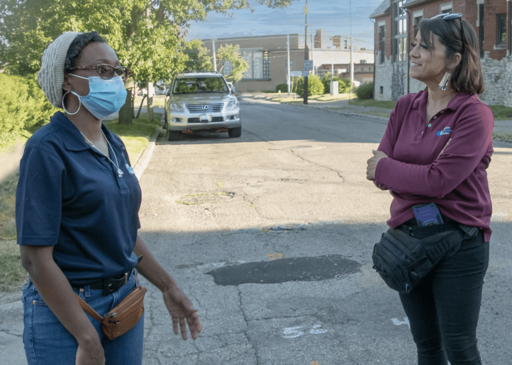Albuquerque created its Community Safety department in 2020. Community Safety is its own city department, like the fire department or the police department, and is considered the city’s third branch of public safety, Ruiz-Angel said. It is one of the largest crisis response programs in the country, with 130 employees. When a call comes into 911 that the Community Safety department is eligible to respond to, dispatchers will send one of three types of Community Safety teams.
In Dayton, Ohio, the city established a Mediation Response Unit (MRU) in 2022 to respond to low emergency 911 calls, such as calls involving disputes between neighbors, child custody exchanges, or barking dogs, Raven Cruz Loaiza, a coordinator for the program, said in an interview. The MRU is small—just seven members—and is a program under the umbrella of the Dayton Mediation Center, a city agency. MRU members are unarmed and wear black pants and maroon polos with “Mediator” written on the back. The goal is to resolve conflicts between community members without police involvement.
While many crisis response programs are new, they’re already delivering results. Since it began operating two years ago, the Albuquerque Community Safety (ACS) department has diverted more than 33,000 calls from the city’s police department, according to data shared with The Appeal. In a significant portion of ACS calls, the department connected the person in crisis to service providers—such as shelters or substance use programs—instead of jail cells. A 2022 Stanford University study of Denver’s crisis response program found that reports of low-level crimes fell by 34 percent in neighborhoods where the city’s Support Team Assistance Response (STAR) program operated. The study also suggested that the crisis-response team saves taxpayers money, as incarceration is more expensive than treatment and support services.



Yay! Finally some unignorable proof that non police conflict resolution works, we couldn’t be more pleased!
So 33,000(cases)/130(workers)/4 (year)/260(~ work days a year)… each worker handles 0.24 cases a day… And that’s “unignorable proof” that it’s working? No offense, but this screams TSA levels of incompetence to me if we’re talking about results.
But the article confuses me. It says that ACS was created in 2020, then referenced “since it started 2 years ago” (2022, article was written 2024)… the number could be 0.48 cases a day/employee… which is still very very little. By that metric half the days people are at work, they’re not active on any case… at best.
I’m wholly on-board for a non-police response to some calls, or I guess in a more perfect world a social worker embedded police presence (since you just never know… a social worker on every call a police officer goes on could be interesting overall. Most cops are solo these days anyway). But this article is easily ignore-able if you’re just looking at the numbers of what’s being discussed.
Edit: Formatting.
You’ve taken their current employee count, as the biggest department of its kind, and assumed they started with that on day 1, which is an unrealistic assumption to make without evidence.
Cool. Then you can give me a better figure or statistic? I mean even if we make the 33000 representative of 1 year (giving them either 1 or 3 years of ramp up time) it’s still not even close to good. .24 cases A DAY is so bad that even if you 8x it it’s not good.
Individual Productivity is the wrong metric here. If you want to see the impact, I would say percentage of police calls diverted would be better. I will also say, these are still early days (whether it is 2 or 4 years), and this kind of thing takes time to establish. Cops and community members have to know it is an option and utilize it.
Read the article. They divert calls to 911. This has nothing to do with cops/people knowing it’s an option but the department diverting calls to themselves rather than taking up 911/police/other first responder duties. I would not suspect that it takes 2-4 years for a team that is directly tied into the system, monitoring and diverting 911 calls to establish themselves… and if they do. Then they are VERY ineffective.
I would agree to some extent… So how come they didn’t provide those metrics? I’m left to only evaluate based on the ones they decided to provide. But a reason %diverted is bad, if 10 calls come in and they diverted 8 of them, 80% is great! except… that 130 person team only doing 10 calls per day seems quite underwhelming. So I would actually much rather the raw number of how many calls occurred during the same 2 or 4 year period overall to compare diverted/overall and make an actual fair assessment there.
Edit: I decided to do their job for them a little bit. Pesky Journalists…
https://www.abqjournal.com/clickable/its-911-new-mexicans-call-emergency-number-48-more-than-new-yorkers/article_0c465702-d507-11ee-a46d-071047195f95.html
So Albuquerque has a population of 558,736 currently according to some random site. I’ll just assume that number for 2020-2024 statically.
so 558736*1.1693 (annual), 653330 calls / year. over 4 years… 2613320
So they took 33000/2613320= 1.26% of calls over the 4 year period… double that if it’s really 2 years.
…that the Republicans will continue to ignore.
Doesn’t matter if it’s built anyway. They can ignore it all they want whilst we dismantle the shitty systems in place.